Hello, Dear Reader
This edition of Cultural Canvas takes us to Germany. Nestled in the rugged embrace of the Bavarian Alps, Neuschwanstein Castle rises like a vision from a storybook, its turrets piercing the mist, its white walls gleaming against the forested slopes. Dubbed the fairy-tale castle, it is among the world’s most recognizable landmarks—an inspiration for Disney’s Cinderella Castle and a magnet for 1.4 million visitors each year.
Yet, beneath its romantic veneer lies a complex tapestry of ambition, eccentricity, tragedy, and contradiction.
To understand Neuschwanstein is to peel back layers of history, art, and human obsession, revealing not just a monument to beauty but a mirror of its creator’s psyche and the turbulent era that shaped it.
So, in today’s edition, let’s embark on a journey through Neuschwanstein’s soaring highs and shadowed depths, uncovering lesser-known facets that make it more than just a postcard-perfect landmark.
The Dreamer and His Vision
Neuschwanstein was the brainchild of King Ludwig II of Bavaria, a monarch as enigmatic as the castle itself. Crowned at 18, Ludwig was less a ruler than a dreamer, ill-suited to the political machinations of a rapidly modernizing Europe. His passion lay in art, music, and mythology, particularly the operas of Richard Wagner, whose works fueled his imagination.
Neuschwanstein, begun in 1869, was not a fortress for defense or a seat of governance but a personal sanctuary—a physical manifestation of Ludwig’s obsession with medieval romance and Wagnerian ideals.
The castle’s design, crafted by theatrical set designer Christian Jank rather than a traditional architect, reflects this theatricality. Its Romanesque Revival style, with pointed arches, ribbed vaults, and ornate frescoes, evokes a mythologized Middle Ages rather than historical accuracy.
Ludwig envisioned Neuschwanstein as a retreat where he could live as a medieval knight, surrounded by murals depicting Germanic legends, such as the Swan Knight Lohengrin.
The Throne Room, with its gilded chandelier and Byzantine-inspired dome, resembles a stage set for a king playing at divinity. Yet, this was no mere aesthetic indulgence. It was a deliberate rejection of the industrial, rationalist 19th century, a world Ludwig found alienating.
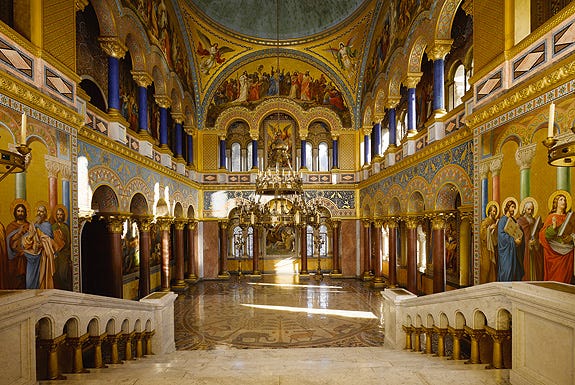
Ludwig insisted on incorporating cutting-edge technology into his medieval fantasy. The castle boasted flush toilets, central heating, and even a telephone line—innovations that jarred with its archaic aesthetic.
This juxtaposition reveals Ludwig’s paradox: a man yearning for the past while embracing the future’s conveniences.
Cultural Canvas is a reader-supported publication. Every like, comment, share, or donation helps us grow—your support truly matters!
The Cost of a Dream
Neuschwanstein’s beauty came at a staggering cost, both financial and personal. Ludwig funded the castle largely from his personal fortune, draining Bavaria’s royal coffers. By 1886, the project had consumed over 6 million marks (roughly €30 million in today’s money), leaving it unfinished at Ludwig’s death.
The castle’s lavish interiors—only 14 of its 200 rooms were completed—feature intricate wood carvings, gold leaf, and murals that took years to craft.
The Singers’ Hall, inspired by Wagner’s Parsifal, alone required meticulous work by artisans who labored under Ludwig’s exacting standards. This extravagance fueled criticism.
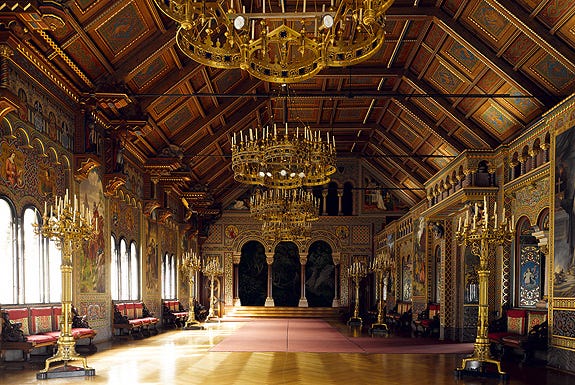
Ludwig’s ministers and the Bavarian public grew resentful, viewing the castle as a symbol of his detachment from governance.
Bavaria, caught in the unification of Germany under Prussian dominance, needed a pragmatic leader, not a king lost in fantasy.
Ludwig’s obsession with Neuschwanstein and other projects like Linderhof and Herrenchiemsee earned him the moniker Mad King Ludwig, a label that oversimplifies his complex character.
Was he mad, or simply misunderstood?
Some suggest he may have suffered from social anxiety or a personality disorder, exacerbated by the pressures of a throne he never wanted.
The Dark Side of the Fairy Tale
Neuschwanstein’s story is not all shimmering turrets and romantic ideals. Ludwig’s reign ended in tragedy, casting a shadow over the castle’s legacy.
In 1886, he was declared insane by a state commission—based on dubious evidence and without a proper examination—and deposed. Days later, he was found dead in Lake Starnberg alongside his psychiatrist, Dr. Bernhard von Gudden, under mysterious circumstances.
Was it suicide, murder, or an accident?
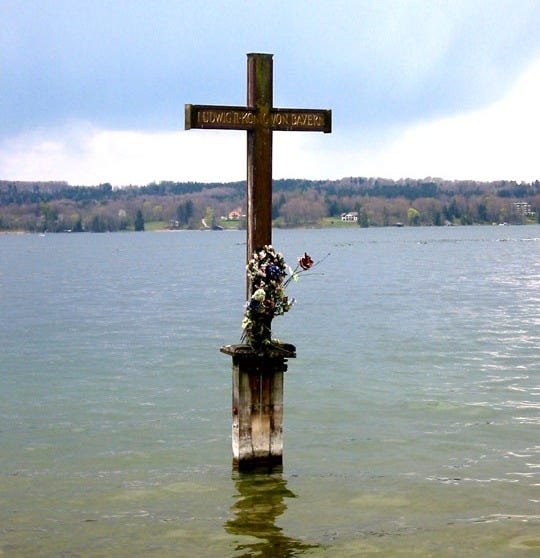
The lack of an autopsy and conflicting accounts fuel speculation to this day. Some theories point to political enemies, wary of Ludwig’s erratic spending and resistance to Prussian influence, orchestrating his removal. Others suggest Ludwig’s despair drove him to take his own life.
The castle itself became a pawn in this drama.
After Ludwig’s death, it was opened to the public within weeks to recoup costs, a move that would have horrified the reclusive king, who intended Neuschwanstein as a private refuge. This commercialization underscores a grim irony: a monument to solitude became one of the world’s most visited sites, its mystique exploited for tourism.
A Cultural and Political Symbol
Neuschwanstein’s significance extends beyond Ludwig’s personal saga. It embodies the 19th-century tension between romanticism and modernity. As Europe industrialized, many, like Ludwig, looked to the past for solace, reviving medieval aesthetics in art, literature, and architecture.
Neuschwanstein, with its idealized vision of knighthood and chivalry, is a pinnacle of this Romantic revival, yet its technological innovations betray its modern roots.
This duality makes it a fascinating artifact of its time, neither fully medieval nor wholly modern.
Politically, the castle reflects Bavaria’s struggle for identity within a unifying Germany. Ludwig’s devotion to Bavarian culture and his resistance to Prussian dominance are evident in Neuschwanstein’s celebration of Germanic myths. Yet, his apolitical stance and focus on personal projects weakened Bavaria’s position, contributing to his downfall.
The castle, then, is both a love letter to Bavarian heritage and a monument to its king’s isolation.
Neuschwanstein Today: Myth and Reality
Today, Neuschwanstein is a global icon, its image plastered on everything from jigsaw puzzles to travel brochures. Its influence on popular culture is undeniable—Disney’s Sleeping Beauty Castle drew direct inspiration from its silhouette. Yet, this fame comes with downsides.
The castle’s remote location struggles to accommodate the influx of tourists, leading to overcrowding. The delicate interiors, designed for a solitary king, suffer wear from millions of footsteps, requiring constant preservation efforts. Moreover, the castle’s romantic image often overshadows its darker history.
The narrative of Ludwig as a tragic dreamer glosses over the economic burden his projects placed on Bavaria and the murky circumstances of his death. Also, the castle’s role as a tourist magnet risks reducing it to a superficial symbol, stripping away its historical and psychological depth.
Neuschwanstein houses a hidden grotto, an artificial cave complete with stalactites and a waterfall, where Ludwig could indulge his Wagnerian fantasies. This surreal space, rarely highlighted in tourist guides, underscores the castle’s role as a stage for Ludwig’s private theatricality.
A Castle of Contradictions
Neuschwanstein is a paradox: a medieval fantasy built with modern technology, a private retreat turned public spectacle, a monument to a king’s dreams that hastened his downfall. It is breathtakingly beautiful yet born of obsession. A cultural treasure yet a financial albatross.
To visit Neuschwanstein is to step into Ludwig’s mind—a place of soaring imagination and profound isolation. Its turrets may gleam in the Alpine sun, but its shadows tell a story of a man and a nation at odds with their time.
Neuschwanstein, beyond its fairy-tale facade, offers a lesson in the cost of dreams.
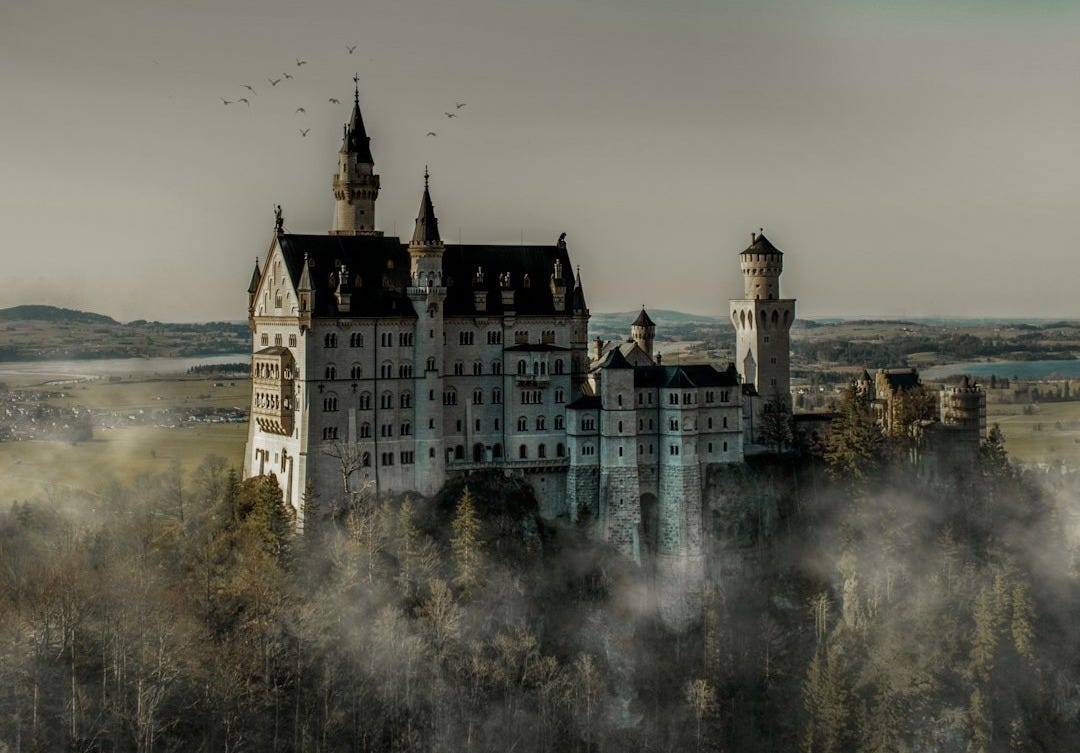
Ludwig’s castle reminds us that beauty, however transcendent, often comes with sacrifice. Even the most enchanting creations carry the weight of their creator’s flaws—a reflection on the delicate line between genius and madness, myth and reality.
Thank you for reading! Until next time, stay curious and in search of beauty.
Muse
Cultural Canvas is a reader-supported publication. Every like, comment, share, or donation helps us grow—your support truly matters!
Missed our last story?




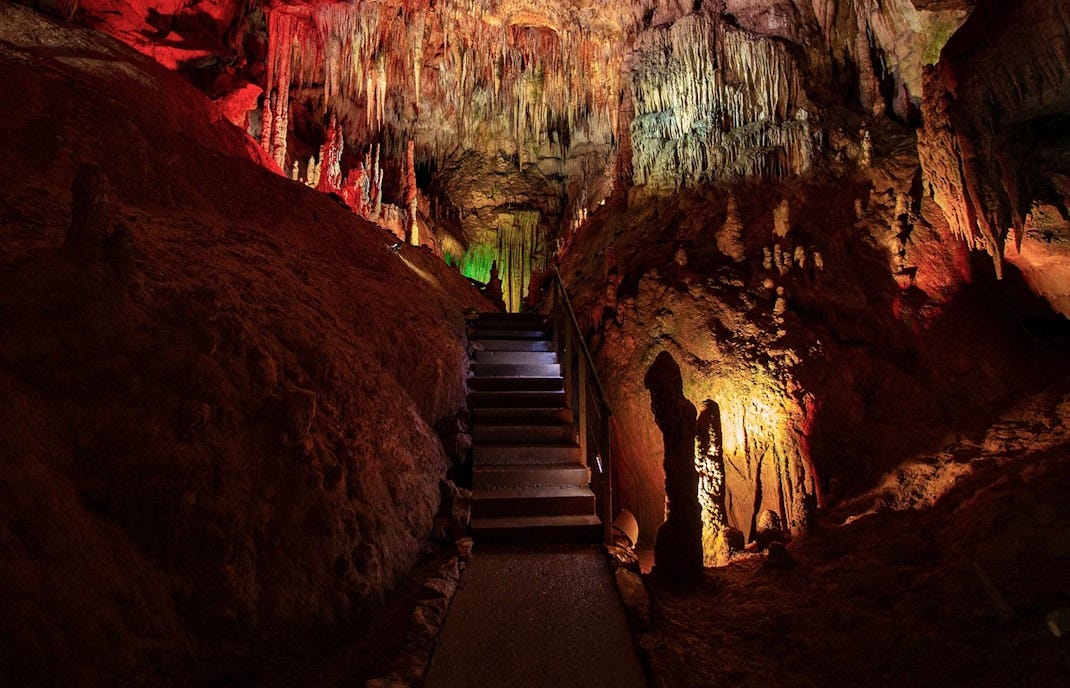
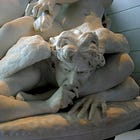
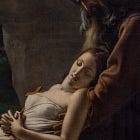
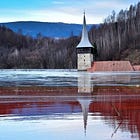
Was Ludwig mad or misunderstood? Quite possibly but I think he was most certainly obsessed with Neuschwanstein Castle which may have been a way of maintaining control over something - versus his apparent shortcomings at governance of his country.
Wonderfully written!!